Environment: milieu / climate zone / depth range / distribution range
Ecologia
marino associati a barriera corallina; distribuzione batimetrica 1 - 60 m (Ref. 1602). Tropical; 35°N - 35°S, 95°E - 125°W (Ref. 47838)
Indo-Pacific: East Africa (south to Port Alfred, South Africa, Ref. 5372) to the Hawaiian, Marquesan, and Ducie islands, north to southern Japan, south to the Lord Howe and Rapa islands; throughout Micronesia.
Size / Peso / Age
Maturity: Lm ? range ? - ? cm
Max length : 20.0 cm TL maschio/sesso non determinato; (Ref. 9710); common length : 16.0 cm TL maschio/sesso non determinato; (Ref. 48636)
Spine dorsali (totale) : 12 - 13; Raggi dorsali molli (totale) : 19 - 23; Spine anali: 3; Raggi anali molli: 18 - 20.
Occur in small groups in reef flats, clear lagoon and seaward reefs (Ref. 48636). Benthopelagic (Ref. 58302). Feed on soft and hard corals, also on polychaetes, small crustaceans, and filamentous algae. In Indonesia, usually seen at moderate depths, usually swimming in small groups. Adults are mainly in depth 20-60 m (Ref. 48636). Oviparous (Ref. 205), monogamous (Ref. 52884). Form pairs during breeding (Ref. 205).
Life cycle and mating behavior
Maturities | Riproduzione | Spawnings | Egg(s) | Fecundities | Larve
Distinct pairing (Ref. 205). Monogamous mating is observed as both obligate and social (Ref. 52884).
Myers, R.F., 1991. Micronesian reef fishes. Second Ed. Coral Graphics, Barrigada, Guam. 298 p. (Ref. 1602)
IUCN Red List Status (Ref. 130435)
Threat to humans
Harmless
Human uses
Pesca: scarso interesse commerciale; Acquario: Commerciale
Strumenti
Special reports
Download XML
Fonti Internet
Estimates based on models
Preferred temperature (Ref.
123201): 24.3 - 28.8, mean 27.6 °C (based on 518 cells).
Phylogenetic diversity index (Ref.
82804): PD
50 = 0.5000 [Uniqueness, from 0.5 = low to 2.0 = high].
Bayesian length-weight: a=0.02818 (0.01692 - 0.04693), b=3.00 (2.86 - 3.14), in cm total length, based on LWR estimates for this species & Genus-body shape (Ref.
93245).
Trophic level (Ref.
69278): 3.3 ±0.3 se; based on diet studies.
Resilienza (Ref.
120179): Alto, tempo minimo di raddoppiamento della popolazione meno di 15 mesi (Preliminary K or Fecundity.).
Fishing Vulnerability (Ref.
59153): Low vulnerability (10 of 100).
Nutrients (Ref.
124155): Calcium = 85.1 [45.0, 130.0] mg/100g; Iron = 0.753 [0.453, 1.216] mg/100g; Protein = 18.6 [17.5, 19.7] %; Omega3 = 0.122 [0.077, 0.193] g/100g; Selenium = 36.2 [20.8, 66.5] μg/100g; VitaminA = 48.7 [14.5, 161.6] μg/100g; Zinc = 1.3 [0.9, 1.8] mg/100g (wet weight);
